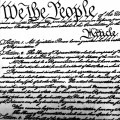One thing is to kill a man and get convicted of murder. Quite another is to kill a man and get convicted of violating his civil rights.
The latter, it turns out, can be a lot harder.
Since the shooting death of 18-year-old Michael Brown in Ferguson, Mo., the Department of Justice and the FBI have been investigating the events surrounding his death. A big question is whether officer Darren Wilson can be federally prosecuted.
In this case, the federal government can’t pursue a murder conviction; that’s the province of Missouri authorities under state law. What DOJ can do is seek to indict Wilson under 18 U.S.C. § 242, the federal criminal civil-rights statute.
Therein lies the problem.
Section 242 is not just any criminal statute. It is a Reconstruction Era law that sought to vindicate rights enshrined in the Fourteenth Amendment—an “antidiscrimination measure” designed to protect the newly acquired rights of blacks.
As history would have it, the U.S. Supreme Court was once called to interpret the statute in Screws v. United States. The case centered around the death of Robert Hall, a black man who was beaten to death after officers claimed he had reached for a gun.
Does that sound familiar?
The court called the case “a shocking and revolting episode in law enforcement,” but more importantly, it upheld the statute from attacks that it was unconstitutional. It has been a valuable prosecutorial tool for the federal government since.
But as effective as Section 242 has been, as written, it sets an extremely high bar for conviction. The law requires a federal prosecutor to prove, beyond a reasonable doubt, that a government actor “willfully” deprived someone of his or her civil rights. Depending on the gravity of the deprivation, the statute allows up to life imprisonment or even the death penalty.
All of this looks good on paper, but the hardest part is proving that the deprivation of civil rights—or in Brown’s case, that his life was taken without due process—was undertaken “willfully.”
Proving willfulness is difficult because DOJ would need enough evidence to essentially get inside Wilson’s mind—to show that he had the criminal intent to deprive Brown of his constitutional right to life. In criminal-law speak, this is the mens rea of Section 242.
Of all the elements of a criminal offense, the mens rea is often the hardest to prove to a jury. How do you get into someone’s mind?
The easiest way is with a confession. If Wilson had confided in someone that he harbors animus for black teenagers and DOJ somehow got a hold of this information, then the department could possibly use this confession against him.
But even that’s not enough. Ideally, DOJ would need evidence that Wilson specifically targeted Brown because he was black. That’s a huge piece of evidence, and one DOJ is unlikely to uncover, if it uncovers it at all.
This explains reports that the FBI has interviewed “hundreds” of witnesses, and Attorney General Eric Holder’s statement that the investigation “will take time to complete.” It’s very likely the bulk of the government’s case will center on Wilson’s mind at the time of the shooting. And making that case will be hard.
When Section 242 and similar statutes were enacted in the mid-1800s, Congress’ intent was to go after egregious abuses of power on account of race—lynchings, mob killings, sham trials, unlawful arrests. Whether the law covers Wilson’s conduct remains to be seen.

Pingback: The curious case of the Ferguson probe | Rights | Derechos
Pingback: Ferguson probe: The next best thing | Rights | Derechos